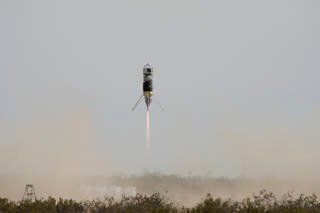
Image credit: NASA (Source: NASA )
NASA is dynamic a laser-based innovation meant to help the rocket with incoming on a disreputable dime for missions to the Moon and Mars. The innovation can undergo testing on forthcoming suborbital rocket dispatches with Blue Origin on its New Shepard rocket and ride to the moon some business landers as a feature of the Artemis program. All the while, organizations are utilizing the innovation to assist self-driving vehicles to explore serious traffic on this planet.
NASA engineers are coming up with how to influence firmly deal with various outings to the Moon and Mars that would incorporate transference huge amounts of logical and life-uphold gear ahead of time of maintained missions.
It assists with contrasting the proposed challenge with past arrivals: the Curiosity wanderer, NASA's most exact Mars arriving at date, had an objective arrival region 12 miles in length and 4 miles wide. Future missions will require various gracefully conveyances just as individuals to land inside two or three hundred yards of one another. Just an exactness arrival and peril shirking framework can make that conceivable.
Future moneylenders may utilize a full set-up of innovation, including cutting edge sensors, cameras, specific calculations, and a superior spaceflight PC that all work in the show. NASA composed the advancement of these abilities under the Safe and Precise Landing – Integrated Capabilities Evolution venture or SPLICE . Furthermore, even as SPLICE plans for its first suborbital dry run on an up and coming organization trip with Blue Origin, a portion of the advancements utilized on it and encouraged en route are turning off into the business part.
Lidar is a detection system like radar that utilizations light waves rather than radio waves to recognize objects, describe their shape, and compute their separation. SPLICE utilizes another variety called navigation Doppler lidar , or NDL.
NDL co-innovator Farzin Amzajerdian, who is the innovation's key agent at NASA's Langley Research Center in Hampton, Virginia, clarified that the recurrence of the framework's laser is, at any rate, three significant degrees higher than radars.

Image credit: Lauren Hughes (Source: NASA )
Earthly Applications
Steve Sandford, previous designing chief at Langley, likewise accepted the innovation had vital earthbound applications. He upheld the advancement of Christian Johann Doppler measuring device throughout his residency at NASA, seeing beginning outcomes direct. within the wake of resigning, he framed Psionic LLC, located in Hampton, Virginia.
In 2016, the organization licensed Doppler lidar innovation from Langley. It likewise went into an area Act Agreement with the center to use NASA offices and talent whereas increasing its business rendition of the innovation for utilizes on this planet even as developing it for space applications, for example, satellite arrivals.
Psionic is reengineering the equipment, labor drove by Diego Pierrottet, a measuring device co-creator once he worked at NASA and currently a boss designer at Psionic. Sandford aforesaid the work contributed by NASA for quite a very long time makes it possible for Psionic to create up an appropriate collecting cycle to enter the market.
Psionic has protection shoppers utilizing the adjusted innovation to diminish the impact on setting down an airplane, improve the safety of in-air refueling, and acknowledge drones, as per Sanford. Space organizations are work utilizations of the innovation in meeting and distance tasks and accuracy incoming on the Moon and Mars.
Also, within the automobile business, clients are making self-driving frameworks for vehicles that will utilize the innovation in both route and crash shirking.
"Doppler lidar's high goal can recognize objects that are just a few inches separated and even a good ways off of a few hundred feet," clarified Sandford.
This issues when a walker is going across a street or a truck is going before a structure. Calculations need exact information to figure out what the article is – individual, building, or truck – and if it's in the way of the vehicle, evading the conceivably lethal mix-up of not easing back down or halting in time.
Additionally, a game-changing attribute of this lidar is that it just observes the laser light it creates, disregarding the laser light sent from different lidars.
Exactness Vision
The graft is the result of numerous long stretches of advancement. In prior stages, NASA tried an alternate sort of 3D imager lidar considered a worldwide screen streak lidar that is additionally finding a utilization for self-driving vehicles.
Dissimilar to the single stream of laser beats in customary lidar, worldwide screen streak lidar obtains information over a pixel cluster, utilizing a solitary laser heartbeat to create the whole guide, Amzajerdian said. This considers a lot of quicker outcomes.
It additionally essentially lessens the computational burden, since all the information is gotten at a similar second and in a similar physical area – no speed counts are important.
In 2014, NASA showed an independent arrival utilizing the innovation in a forerunner venture to SPLICE.
Worldwide screen streak lidar was designed by Santa Barbara, California-based Advanced Scientific Concepts Inc. (ASC). Even though it had just started, quite a long while of subsidizing from NASA's Small Business Innovation Research (SBIR) program and other venture reserves were instrumental to its culmination.
Reference:
Thanks for your contribution to the STEMsocial community. Feel free to join us on discord to get to know the rest of us!
Please consider supporting our funding proposal, approving our witness (@stem.witness) or delegating to the @stemsocial account (for some ROI).
Thanks for using the STEMsocial app and including @stemsocial as a beneficiary, which give you stronger support.